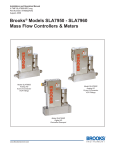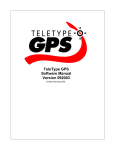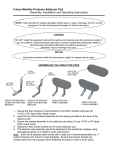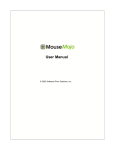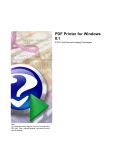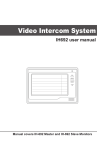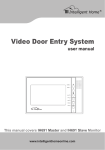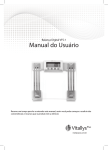Download phpSHIELD User Manual
Transcript
Version 3.0 Copyright 2002-2005 phpSHIELD Introduction An introduction to phpSHIELD This phpSHIELD User Manual covers all of the features necessary for you to encode and protect your scripts. If there is anything that you feel has been omitted from this user manual, then please let us know as we are passionate about providing excellent service. Have fun using your new product... phpSHIELD 3.0 Copyright 2002-2005 phpSHIELD All rights reserved. No parts of this work may be reproduced in any form or by any means - graphic, electronic, or mechanical, including photocopying, recording, taping, or information storage and retrieval systems - without the written permission of the publisher. Products that are referred to in this document may be either trademarks and/or registered trademarks of the respective owners. The publisher and the author make no claim to these trademarks. While every precaution has been taken in the preparation of this document, the publisher and the author assume no responsibility for errors or omissions, or for damages resulting from the use of information contained in this document or from the use of programs and source code that may accompany it. In no event shall the publisher and the author be liable for any loss of profit or any other commercial damage caused or alleged to have been caused directly or indirectly by this document. I phpSHIELD User Manual Table of Contents Foreword 0 Part I Introduction 3 1 About phpSHIELD ................................................................................................................................... 3 2 How to buy ................................................................................................................................... 3 3 Features ................................................................................................................................... 3 Part II GUI manual 1 Overview 6 ................................................................................................................................... 6 2 First run - obtaining ................................................................................................................................... license 6 3 Settings ................................................................................................................................... 8 4 Encoding ................................................................................................................................... 9 Part III Protected script loaders 12 1 Loader filename ................................................................................................................................... structure 12 2 Automatic loading ................................................................................................................................... 12 3 Manual installation ................................................................................................................................... 13 Part IV Common mistakes 16 1 Encoded scripts ................................................................................................................................... modification 16 2 Extension directory ................................................................................................................................... (php.ini setting) 16 Index 17 © 2002-2005 phpSHIELD phpSHIELD 3.0 Part I 3 phpSHIELD User Manual 1 Introduction 1.1 About phpSHIELD We created phpSHIELD to be a low-cost, but powerful, alternative to some of the more expensive encoding solutions out there. Our encoder is as good as, if not better in some respects, than other encoders currently selling for thousands of dollars. We pride ourselves on the quality of our products and have created phpSHIELD as a low-cost product that any developer - whether a freelancer or a corporation - can afford to protect and encode their software. The protected code is fully native bytecode, with an encryption layer on top of it and this means that it is not possible to reverse engineer back to the original script, as this script has been removed. phpSHIELD was created by a global team of PHP experts, who are based in the USA, UK and Russia. Thank you for purchasing our product - we hope that you enjoy using it, and if you have any suggestions, please let us know With thanks The phpSHIELD team 1.2 How to buy To purchase phpSHIELD, please visit the following: https://phpshield.com/purchase/ 1.3 Features phpSHIELD Features List Fully native byte code encoding Native encoding to fully protect your application PHP5 and PHP4 support Both PHP5 and PHP4 support built in to the encoder and loaders Fast encryption Powerful and fast encryption to protect your files Easy to use A simple and easy to use interface. Three steps and your files are protected Windows encoding client and loaders Simple and easy to use Windows client encoder and loaders Linux ready loaders Linux ready loaders for running protected scripts MacOSX ready loaders MacOSX support. We support php under Mac OS X Protect your intellectual property Protect your intellectual property. Protect your php source code. Peace of mind for only $55 © 2002-2005 phpSHIELD Introduction Evaluation We provide a Free 7 days evaluation of phpSHIELD © 2002-2005 phpSHIELD 4 phpSHIELD 3.0 Part II GUI manual 2 GUI manual 2.1 Overview 6 phpSHIELD protects your PHP Source Code with a powerful, easy to use encoder, which creates a native bytecode version of the script and then encrypts it. Some other PHP encoding systems do not use bytecode and it is very easy to reverse engineer their protected scripts back to the original source code. With bytecode encryption, it is never possible to do this as the original sourcecode has been completely removed from the protected file. phpSHIELD has been developed to help software authors, freelance developers and anyone publishing scripts to protect their intellectual property with ease. Developers working on freelance projects do not have to give away all of their legacy code during a project - phpSHIELD will allow them to protect the elements at they do not want the client to have full access to. Software authors can release their scripts without the fear of losing revenue from piracy. Encrypted and protected code works under Windows, Linux and now Mac OS X. Your encoded scripts will work with no changes to the default installations of PHP. 2.2 First run - obtaining license On your first of run of phpSHIELD you should see following screen: © 2002-2005 phpSHIELD 7 phpSHIELD User Manual This screen means that you need to obtain a license first in order to run phpSHIELD. Obtaining a license. You need a direct connection to the internet or configure a Proxy server so that the phpSHIELD application can connect to the internet. NOTE: Some firewalls may prohibit phpSHIELD from connecting to the internet, so you may have to enable internet access for phpSHIELD. On how to enable internet access for a custom application with your firewall please consult your firewall documentation. When you purchase the full version of phpSHIELD, or request demo version of it, you will receive an email with details on how to access your profile on our site. This email contains a user name and a profile password. Just type them into the 'User name' and 'Password' fields and click on the 'Get License' button. After the license has been downloaded you will see a message box saying: "Application will now close. Please start the application again to activate your copy". Press 'Ok' and then start the program again. If everything has installed correct, the application will start normally. If anything has gone wrong with the installtion, you will see the 'License error' screen again. Make sure you enter your user name and password correctly, check your internet settings and try again. Configuring internet connection. This is useful if you normally need to access the internet via a proxy server. Direct connection - This is selected by default and is used when you have a direct internet connection. Use Proxy Server - Select this option if you are behind a Proxy Server. Enter the Proxy Server address and the Port. Also the Proxy Username and Password should be entered if it is applicable. Please © 2002-2005 phpSHIELD GUI manual 8 consult your network administrator about information about your Proxy Server. 2.3 Settings Encoder options Default project settings This allows you to set up default project settings so that when you start the New Project then these settings will be the default for your projects. Filter for files to encode Extensions to encode - here you can list an extension that you wish to encode when you add files/directories to your project. You should separate extensions by commas. For example: *.php,*.php4,*.inc Extensions to copy as-is - here you can list extensions that will be marked to copy as-is (ie without any encoding) when you add files/directories to your project. You should separate extensions by commas. For example: *.html,*.tpl,*.txt Backup options This option is used when you want to encode files in the same place (with overwrite of source scripts). For example: bak © 2002-2005 phpSHIELD 9 2.4 phpSHIELD User Manual Encoding Encoding process is simple like 1-2-3. 1.Choose files. Use a mouse right click on the treeview to get a popup menu. There you can select what you would like to do (add file(s), add folder, rename, remove, remove all, create directory, mark file/dir to encode or to not encode). Also you can drag and drop objects inside this treeview. Operations on multiple selected objects are allowed. 2. Output options. Once you have added files into your project you need to select your output options. Here you need to specify the target version of PHP - either 4 or 5. Your encoded PHP scripts will only run under this version of PHP. Next, you need to specify a target directory where the encoded files will be placed. Also you may wish to place phpSHIELD loaders into this directory to deploy them with your encoded project. 3. Encode your files. When you are ready just click the 'Encode!' button. The Encoding window appears saying that encoding has begun. Please wait until it say that encoding has finished. Then you can click the 'Close' button. © 2002-2005 phpSHIELD GUI manual Now you can find the encoded files in the target directory that you specified at the 2nd step. You may wish to save your project to use it later. Goto File->Save project to do it. © 2002-2005 phpSHIELD 10 phpSHIELD 3.0 Part III Protected script loaders 3 12 Protected script loaders Protected script loaders are dynamically loaded PHP extensions which load the protected script, decrypt it and then run the bytecode. The Source code is never restored at any time, even in memory. There are different versions of the loaders available for different operating systems and PHP installations.The appropriate version of the loader will be automatically loaded by the protected script, if this is supported by your web server and PHP configuration. phpSHIELD protected script loaders may also be installed manually in to a php.ini file - This is useful, for example, if automatic loading is not supported or if faster performance is required. Protected Script Loaders will be updated periodically and the latest loaders are always freely available from: http://www.phpshield.com/loaders/ 3.1 Loader filename structure The following provides an overview of the loader naming conventions: phpshield.X.Y.Zdd.os X.Y - major PHP version number (4.3 for 4.3.x, 5.0 for 5.0.x) Z - minor PHP version number (2 for 5.0.2) This part may be missed in the loader name which means that this loader is for all higher PHP versions: · phpshield.4.3.lin - for all PHP 4.3.x versions · phpshield.5.0.0.lin - for PHP 5.0.0 only · phpshield.5.0.1.lin - for PHP 5.0.1 only · phpshield.5.0.2.lin - for PHP 5.0.2 only · phpshield.5.0.lin - for all PHP 5.0.3+ versions and higher - optional code of supported encoder and system: · (missed) - this loader will load scripts protected with full version of phpSHIELD · ev. - this loader will load scripts protected only with the evaluation version of phpSHIELD · ts. - this loader will load scripts protected with the full version of phpSHIELD and is suited for manual installation on systems with Thread Safety enabled PHP (see details below) - three char code of operating system type. Currently supported: · .win - Windows · .lin - Linux · .dar - Mac OS X dd os 3.2 Automatic loading Most operating systems and installations of PHP will load the Protected scripts without any modification. PHP will be able to find and load the appropriate loader if the following conditions are met: 1) Operating system and PHP mode: © 2002-2005 phpSHIELD 13 phpSHIELD User Manual Linux or FreeBSD - PHP installed as CGI or CLI Linux or FreeBSD - PHP installed as Apache module (with thread safety off) Windows - PHP installed as CGI or CLI 2) Thread Safety is disabled. You may check phpinfo() output for this. 3) dl() is enabled. You should have enable_dl=On in your php.ini. 4) The PHP extensions directory needs to exist. Please check that the extension_dir= option in php.ini points to the real directory. Some hosting companies have incorrect installations of PHP and this can cause problems. 5) The latest loaders are installed in an /phpshield/ subdirectory within your scripts directory or any parent directory. Examples are below: Example 1: (loaders are in the /phpshield/ subdirectory within the scripts directory) /home/mysite/www/myscript1.php - your protected script(s) /home/mysite/www/myscript2.php - your protected script(s) /home/mysite/www/subdir/otherscript1.php - other protected script(s) /home/mysite/www/subdir/otherscript2.php - other protected script(s) /home/mysite/www/phpshield/phpshield.* - script loaders Example 2: (loaders are in the /phpshield/ subdirectory within any *parent* directory) /home/mysite/www/myscript1.php - your protected script(s) /home/mysite/www/myscript2.php - your protected script(s) /home/mysite/www/subdir/otherscript1.php - other protected script(s) /home/mysite/www/subdir/otherscript2.php - other protected script(s) /home/phpshield/phpshield.* - script loaders 6) (For windows users only) extension_dir= option in php.ini should point to the directory located *on the same drive* with your document root and scripts directory. 3.3 Manual installation It is possible to Manually install the loader and this is required in the following conditions: 1) Operating system and PHP mode: Linux or FreeBSD - PHP installed as Apache module (with thread safety on) Windows - PHP installed as Apache module (thread safety is always on) 2) If Thread Safety is enabled. You may check phpinfo() output for this. PHP installed as Apache module under Windows will always have Thread Safety on. 3) If dl() is disabled. You have to enable_dl=Off in your php.ini. © 2002-2005 phpSHIELD Protected script loaders 14 Manual installation may be used even if automatic loading is available. With appropriate and manually installed phpSHIELD loaders you give the maximum performance for your protected scripts. This is because the script will not need to search for a loader each time it runs. For manual installation phpSHIELD protected script loaders you should have access to the php.ini configuration file. Manual installation is easy: 1) Check phpinfo() output for PHP version, Thread Safety mode and extension_dir path. 2) Copy the latest loaders into the /phpshield/ subdirectory of your PHP extension_dir 3) Add one line into your php.ini with the appropriate loader name. This will depend on your OS, PHP version, Thread Safety mode and phpSHIELD™ version (full or evaluation). Please refer to the "Loader filename structure" section above. Examples: (These are not the only possible variants, and are just provided as examples) extension=phpshield/phpshield.4.3.lin # for Linux, non thread safe, PHP 4.3.x extension=phpshield/phpshield.5.0.0.lin # for Linux, non thread safe, PHP 5.0.0 extension=phpshield/phpshield.5.0.1.lin # for Linux, non thread safe, PHP 5.0.1 extension=phpshield/phpshield.5.0.2.lin # for Linux, non thread safe, PHP 5.0.2 extension=phpshield/phpshield.5.0.lin # for Linux, non thread safe, PHP 5.0.3+ extension=phpshield/phpshield.5.0.0ts.lin # for Linux, thread safe, PHP 5.0.0 extension=phpshield/phpshield.5.0ts.lin # for Linux, thread safe, PHP 5.0.3+ extension=phpshield/phpshield.4.3.win # for Windows, PHP 4.3.x extension=phpshield/phpshield.4.3ev.win # for Windows, PHP 4.3.x, evaluation version extension=phpshield/phpshield.5.0.2.win # for Windows, PHP 5.0.2 extension=phpshield/phpshield.5.0.win # for Windows, PHP 5.0.3+ extension=phpshield/phpshield.5.0ev.win # for Windows, PHP 5.0.3+, evaluation version © 2002-2005 phpSHIELD phpSHIELD 3.0 Part IV Common mistakes 4 16 Common mistakes This section includes common mistakes that people may make, either in encoding and protecting their files, or in uploading or running these files on the web server. They are not in any particular order, but we would suggest that you look at this section before you contact phpSHIELD regarding any support matter. 4.1 Encoded scripts modification Encoded scripts are protected against modification. Please DO NOT MODIFY any single byte in the encoded scripts or you will get an error executing them. 4.2 Extension directory (php.ini setting) If you want loader to be loaded dynamically using dl() function you have to make sure that extension_dir setting in your php.ini is valid. It should point to a directory that does exists on the server. If it doesn't exists then PHP cannot load any extension at all (including phpshield loader). For windows users only: extension_dir option in php.ini should point to the directory located on the same drive with your document root and scripts directory. © 2002-2005 phpSHIELD 17 phpSHIELD User Manual Index -AAbout 3 Automatic ixed loading 12 -FFeatures 3 -GGUI manual overview 6 -HHow to buy 3 -LLoader filename structure 12 -MManual ixed installation 13 -OObtaining license 6 -SSettings 8 © 2002-2005 phpSHIELD























